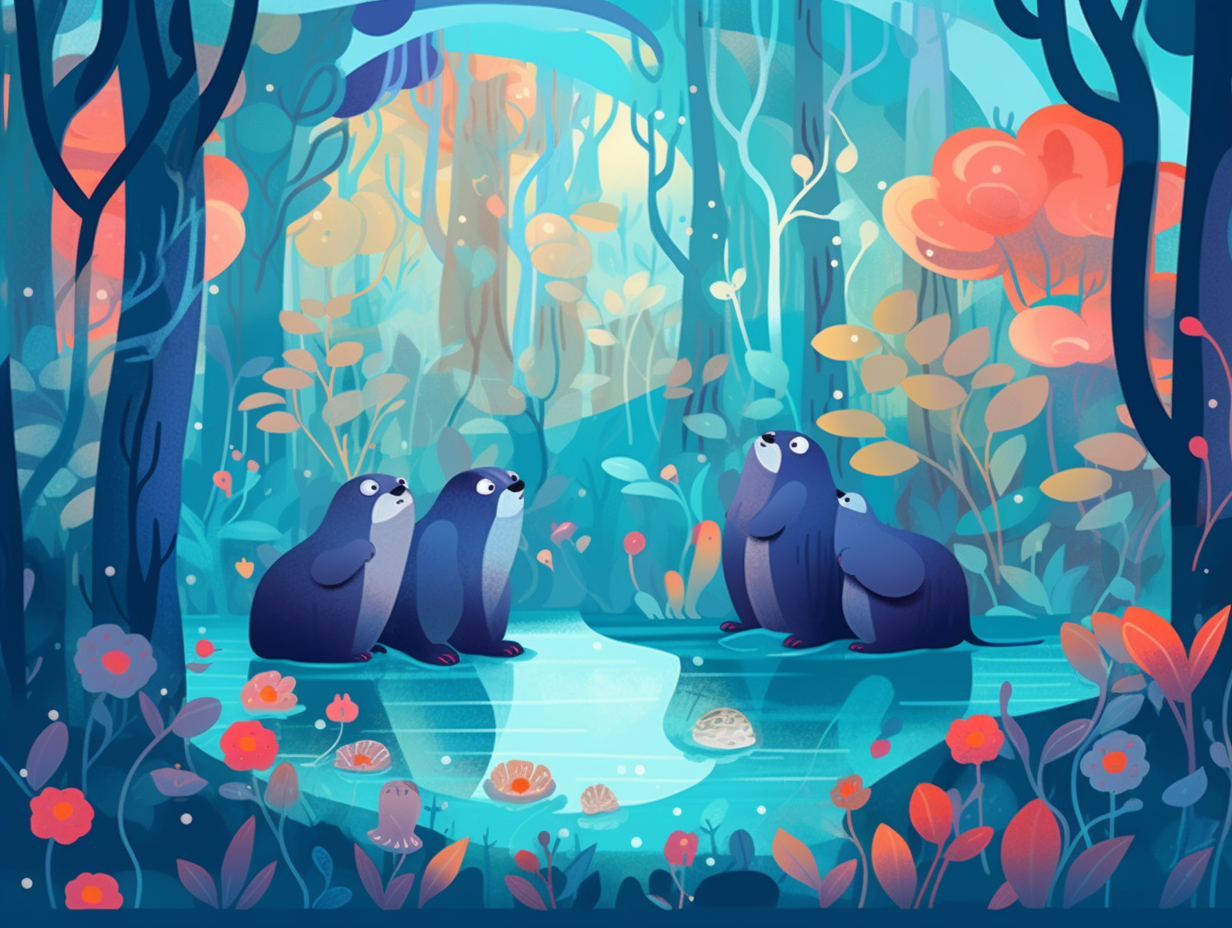20 Otter-ly Amazing Fun Facts: Get Ready to Fall in Love with These Adorable Aquatic Mammals

1. Nightmare Proof Wrappers
Otters: certified nightmare proof wrappers since pre-historic times! These furry, aquatic bedtime burrito enthusiasts have mastered the fine art of snooze-surfing: Otters safeguard their snoozes by wrapping themselves in kelp or giant seaweed whilst napping, preventing drifts away from their group and maintaining a cozy, anchored slumber.
Source => torontopubliclibrary.typepad.com
2. Otter vs Alligator
Otters: the Chuck Norris of the animal kingdom, tackling monsters for breakfast with a side of playfulness. In a jaw-dropping spectacle, a river otter in Florida was caught on camera wrestling and ultimately defeating a young alligator: a testament to their surprising prowess as apex predators and their penchant for fun and games, like mudslide marathons.
Source => nationalgeographic.com

Did you know river otters can stay underwater for up to four minutes while hunting, using their incredible whiskers to find prey in dark waters? Discover their playful side and watery habitats in these fun facts!
=> Fun Facts about River-Otters
3. Juggling Otters
When the going gets tough, the otters get juggling: Research shows that these furry acrobats tend to juggle rocks more often when hungry, with juvenile and older otters primarily engaging in this mysterious yet entertaining behavior as they skillfully snatch shellfish and fish for their next meals.
Source => smithsonianmag.com
4. Otter Stone Age
Move over, cavemen: otters have entered the Stone Age! These furry little sea-dwellers are not just adorable, but they've got an ancient skill up their sleeve (or paw?): sea otters are the only marine mammal known to use stone tools, expertly employing large shoreline rocks as "anvils" to crack open tasty mollusks like mussels. Researchers can even distinguish between human and sea otter-rock usage through ecological and archaeological methods – shedding light on the ingenuity of our otter pals who've been rocking their innovative ways for ages!
Source => shh.mpg.de

5. Otter Pockets
In an otterly resourceful fashion, these aquatic rascals could give Batman's utility belt a run for its money: Otters are equipped with natural pockets under their arms, where they stash their favorite rocks as handy tools for cracking open clams and other shellfish.
Source => dailyedge.ie
6. Otter Food Storage
When otters aren't rocking the Sherlock Holmes deerstalker look, they've definitely got something up their sleeves: Sea otters use their "otter pockets" – flaps of skin under their forearms – to store food and tools while they hunt, tucking away clams, crabs, shrimp, and squid for easy access later on. These crafty critters put magicians to shame with their dexterous pocketing skills!
Source => blog.wcs.org
7. Fuzzy Wetsuits
Who needs a wetsuit when you're a fabulously fuzzy otter? This slippery swimmer has mastered the art of staying warm in the pool while still keeping it au naturel: Otters sport long, oily fur with hollow, scaly guard hairs that protect a dense undercoat, allowing them to lock out water and trap air for extra insulation in frigid temperatures.
Source => apnews.com
8. Versatile Teeth
In a world where "just the tip" can make all the difference, otters have mastered the art of feasting on a sea-buffet using their versatile teeth: equipped with sharp teeth for fish-tearing and blunt teeth for shell-crushing, sea otters even have just two pairs of incisors in their lower jaw to expertly scrape the soft parts of molluscs off Vibrissae.
Source => seaworld.org
9. Breath-Holding Champs
Otters: the real-life definition of taking a plunge and making a splash! They're not just adorable goofballs, they're actually fantastic divers with a hidden superpower: these river rovers can hold their breath underwater for a whopping 8 minutes and even sport a nifty translucent eyelid called the nictitating membrane, which protects their eyes while swimming and hunting underwater.
Source => willyswilderness.org

10. Otters Catch the Flu
Otters might need a sick day too: Turns out, 70 percent of them tested positive for the human H1N1 virus antibodies in 2009, proving that they too can catch the flu just like us!
Source => smithsonianmag.com
11. Bubble Jacket Trendsetters
Who knew otters were part-time fashionistas and part-time scuba divers? These aqua-tastic critters know how to mix high fashion with underwater adventuring, accessorizing with the trendiest of bubble jackets: Otters lack a thick layer of body fat, so they rely on their specially designed underhairs that interlock to trap air bubbles, creating a perfect down jacket and keeping them warm in chilly waters. Talk about naturally chic insulation!
Source => sciencedaily.com
12. Crafty Seafood Dining
Move over, DIY enthusiasts and master crafts-otters! These furry little engineers are running the show when it comes to the art of seafood dining: Sea otters ingeniously use rocks as hammers and anvils to crack open crabs and clams, storing their trusty tools in an armpit storage pouch for easy access whenever hunger strikes.
Source => doi.gov
13. Ecological Superheroes
When otters aren't busy cracking open a cold one with the boys, they're quite the ecological superheroes: Sea otters play a critical role as a keystone species by keeping sea urchin populations in check, thereby preserving kelp forests and creating thriving habitats for numerous other marine creatures.
Source => thekidshouldseethis.com
14. Speedy Swimmers
Move over, Michael Phelps! It's time for some furry, whiskered competitors to steal the aquatic limelight: Giant otters can swim at remarkable speeds of up to 9 miles per hour, while sea otters aren't far behind, hitting up to 5.6 miles per hour underwater, all thanks to their sinuous body and tail movements.
Source => seaworld.org

15. Deep-Dive Experts
Crushing deep-dives like an otterly fantastic marine Olympian: Sea otters can hold their breath for over five minutes, while river otters can last up to eight minutes underwater, providing them plenty of time to sense prey and gather grub.
Source => doi.gov
16. Otter Lung Capacity
Otters, proud members of the H2O fan club, and rumored to be the inspiration behind Olympic swimmer Michael Phelps' impressive lung capacity: these slick creatures can actually hold their breath for an astounding eight minutes underwater.
Source => a-z-animals.com
17. Underwater Buffet
Who ordered the all-you-can-eat underwater buffet?: Otters munch away on 25% to 30% of their body weight daily, which can equal 11kg for a large male, dining on a scrumptious smorgasbord of fish, crabs, sea urchins, and even showcasing their five-star hunting skills with lobsters on the menu, as caught on camera around the Scottish isles.
Source => dailymail.co.uk
18. Tree-Climbing Houdinis
Though they may not possess the lumberjack skills of their more beaverly neighbors, otters sure know how to climb a tree and bolt through tiny gaps: These agile acrobats can shimmy up low-level branches and fallen trees, leap fences under a meter high, and slip through spaces as small as 10cm, proving they are indeed the Houdinis of the animal kingdom.
Source => wildlifefaq.com
19. Nutcracker Suite
Equipped with their very own nutcracker suite, otters are gifted this holiday season in cracking open more than record-breaking ballet performances: Their flat molars specialize in crushing shellfish, while their slightly smaller, yet pointed, canines allow them to efficiently consume their prey without the drama of prominent fangs.
Source => natureconservancy.ca
20. Breath-Holding Wizardry
Behold, the aquatic masters of breath-holding wizardry: sea and river otters! These cunning furballs can give Houdini a run for his money and seriously challenge the world's greatest pearl divers – not bad for creatures that spend half their lives floating belly up: River otters boast an impressive lung capacity, managing to hold their breath for up to 8 whole minutes, while their seafaring counterparts stay submerged for over 5 minutes, granting them ample time to hunt and examine potential meals beneath the waves.
Source => doi.gov
Related Fun Facts




















